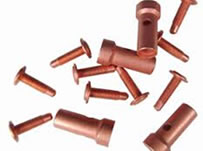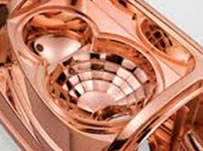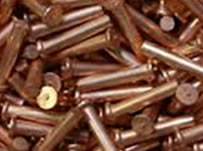

RECUBRIMIENTOS / COATINGS
Copper Plating
Copper is a reddish metal that has many valuable uses ranging from electrical engineering purposes to decorative finishes. It is used on an assortment of products ranging from pennies and bullets to electrical connectors and automotive parts. Copper is used heavily as an underplate due to its ability to adhere extremely well to a variety of different substrates and plate well with other subsequent metals. Copper is the second best conductor of electricity and an excellent conductor of heat. These properties give it a host of engineering applications. Copper is also very ductile and can be buffed to a shine giving the metal a decorative value.
We have two types of copper.
Acid copper
Provides excellent leveling, high macro-throwing power, and high plating speeds. However, acid copper does have limitations. Some metals, such as steel and aluminum, are attacked and etched by the acidic solution. It can also produce immersion deposits that have very poor adhesion. For these metals, a cyanide copper strike must be used prior to plating.
Cyanide copper
Is essential for plating on steel, zinc, and aluminum because it adheres well to them and minimizes immersion deposits. Cyanide copper has excellent throwing power which leads to less thickness variations. This is extremely important when dealing with parts that have complicated shapes
Cyanide copper
Is essential for plating on steel, zinc, and aluminum because it adheres well to them and minimizes immersion deposits. Cyanide copper has excellent throwing power which leads to less thickness variations. This is extremely important when dealing with parts that have complicated shapes
Recubrimiento de Cobre
El cobre es un metal rojizo que tiene muchos usos valiosos que van desde fines de ingeniería eléctrica y acabados decorativos. Se utiliza en una variedad de productos que van desde monedas, conectores eléctricos y piezas de automóviles. El cobre se utiliza en gran medida como un recubrimiento base debido a su capacidad de adherirse extremadamente bien a una variedad de diferentes substratos para cubrirlo con otro acabado. El cobre es el segundo mejor conductor de la electricidad y un excelente conductor de calor. Estas propiedades le dan una gran cantidad de aplicaciones de ingeniería. El cobre también es muy dúctil y se puede pulir a un brillo que le da al metal un valor decorativo.
Tenemos dos tipos de cobre.
Cobre ácido
Proporciona una excelente nivelación, alto poder de penetración y alta velocidad de recubrimiento. Sin embargo, el cobre ácido tiene sus limitaciones. Algunos metales, tales como acero y aluminio, son atacados y marcado por la solución ácida. También puede producir depósitos de inmersión que tienen muy mala adherencia. Para estos metales, una base de cianuro de cobre debe ser utilizado antes del recubrimiento.
Cianuro de cobre
Es esencial para el recubrimiento sobre acero, cinc, y aluminio, ya que se adhiere bien a ellos y minimiza los depósitos de inmersión. El Cianuro de Cobre tiene un excelente poder de penetración que conduce a menos variaciones de espesor. Esto es extremadamente importante cuando se trata de piezas de formas complejas.
 |
 |
 |





